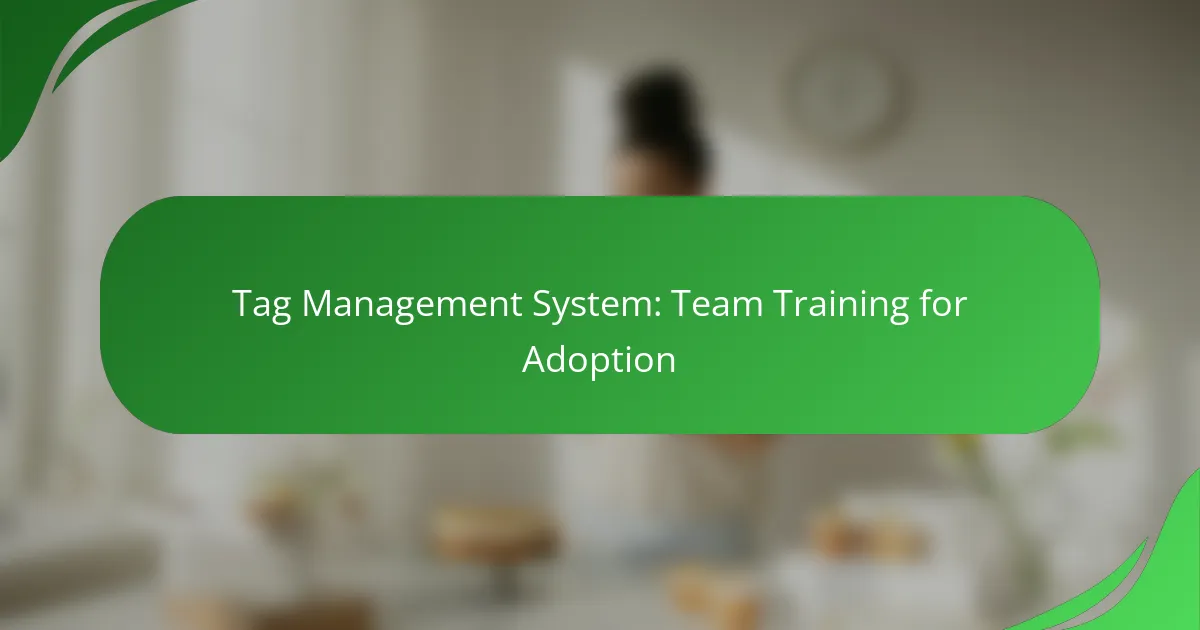A Tag Management System (TMS) plays a crucial role in helping Canadian corporations efficiently manage their marketing tags, leading to improved data accuracy and streamlined operations. By centralizing tag deployment, businesses can enhance their marketing strategies while ensuring compliance with local regulations. Selecting the right TMS involves careful consideration of business needs and integration capabilities, ultimately driving better data collection and marketing effectiveness.

How does a Tag Management System benefit Canadian corporations?
A Tag Management System (TMS) offers Canadian corporations a streamlined approach to managing marketing tags, improving efficiency and data accuracy. By centralizing tag deployment, businesses can enhance their marketing operations while ensuring compliance with local regulations.
Streamlined marketing operations
A TMS simplifies the process of managing multiple marketing tags, allowing teams to deploy and update tags without needing extensive IT support. This leads to quicker campaign launches and reduced reliance on developers, enabling marketing teams to focus on strategy rather than technical hurdles.
For instance, a corporation can implement changes to tracking codes across various platforms in a matter of minutes, rather than days, which significantly accelerates time-to-market for campaigns.
Enhanced data accuracy
By using a TMS, Canadian corporations can improve the accuracy of their data collection. A centralized system reduces the risk of errors that can occur when managing tags manually across different platforms.
With features like version control and testing capabilities, businesses can ensure that the correct tags are firing and collecting data as intended, leading to more reliable analytics and insights.
Improved compliance with regulations
In Canada, compliance with privacy regulations such as PIPEDA is crucial for corporations. A TMS can help ensure that data collection practices align with these regulations by providing tools to manage consent and data usage effectively.
By implementing a TMS, companies can easily adjust their tagging strategies to comply with changing regulations, minimizing the risk of legal issues and enhancing consumer trust.
Faster implementation of tracking codes
Implementing tracking codes can be a time-consuming process, but a TMS allows for rapid deployment. Marketing teams can add or modify tracking codes without needing to involve IT, which speeds up the overall process.
This agility means that businesses can quickly adapt to new marketing strategies or technologies, ensuring they remain competitive in a fast-paced digital landscape.

What are the key features of Tag Management Systems?
Tag Management Systems (TMS) streamline the process of managing and deploying marketing tags across websites and applications. Key features include user-friendly interfaces, version control, integration capabilities, and customizable triggers, all of which enhance efficiency and accuracy in digital marketing efforts.
User-friendly interface
A user-friendly interface is crucial for a Tag Management System, as it allows marketers and non-technical users to easily navigate and manage tags without extensive coding knowledge. Intuitive dashboards and drag-and-drop functionalities enable quick adjustments and real-time updates.
When evaluating TMS options, look for features like visual tag management and clear documentation. This can significantly reduce the learning curve and improve overall productivity.
Version control and rollback
Version control is an essential feature that allows users to track changes made to tags over time. This capability ensures that if a new tag causes issues, users can quickly revert to a previous version without extensive downtime.
Implementing a TMS with robust version control can save businesses from costly errors. Regularly review and document changes to maintain a clear history of tag modifications.
Integration with analytics platforms
Effective integration with analytics platforms is vital for maximizing the benefits of a Tag Management System. A TMS should seamlessly connect with tools like Google Analytics, Adobe Analytics, or other data platforms to ensure accurate data collection and reporting.
When selecting a TMS, verify its compatibility with your existing analytics tools. This integration allows for better tracking of user behavior and campaign performance, ultimately leading to more informed marketing decisions.
Customizable triggers and tags
Customizable triggers and tags enable users to define specific conditions under which tags are fired. This flexibility allows for precise tracking of user interactions, such as clicks, form submissions, or page views, tailored to business needs.
Consider using event-based triggers to capture critical user actions. Ensure that your TMS supports a variety of trigger types to accommodate different marketing strategies and objectives.

How to choose the right Tag Management System for your business?
Choosing the right Tag Management System (TMS) involves assessing your business needs, scalability, integration capabilities, and support options. A well-selected TMS can streamline your data collection and enhance marketing efforts by efficiently managing tags across your digital properties.
Evaluate scalability options
When evaluating scalability, consider how well the TMS can grow with your business. Look for systems that can handle increasing volumes of data and tags without compromising performance. A scalable solution should accommodate future expansions, whether that means adding more websites or increasing traffic.
For example, if your business plans to launch multiple campaigns or expand into new markets, ensure the TMS can support those initiatives without requiring a complete overhaul. Check for features like automated tag deployment and the ability to manage multiple environments seamlessly.
Assess integration capabilities
Integration capabilities are crucial for ensuring your TMS works well with existing tools and platforms. Investigate whether the TMS can easily connect with your analytics, CRM, and advertising platforms. A good TMS should offer pre-built integrations or APIs for custom connections.
Consider the time and resources required for integration. A TMS that requires extensive manual setup may lead to delays and increased costs. Look for solutions that provide straightforward integration processes, ideally with documentation and support to assist your team.
Consider user support and resources
User support is vital for a smooth implementation and ongoing management of your TMS. Evaluate the level of support offered, such as live chat, email assistance, or dedicated account managers. A responsive support team can help resolve issues quickly, minimizing downtime.
Additionally, check for available resources like tutorials, webinars, and community forums. Comprehensive documentation can empower your team to utilize the TMS effectively, reducing reliance on external support and enhancing your internal capabilities.
Review pricing models
Pricing models for TMS can vary significantly, so it’s essential to understand the costs involved. Some systems charge based on the number of tags, while others may have a flat monthly fee. Consider your budget and how pricing aligns with your usage patterns.
Look for transparent pricing structures that clearly outline what is included. Be cautious of hidden fees for features like additional support or advanced functionalities. Comparing several options can help you find a TMS that offers the best value for your specific needs.

What are the implementation steps for a Tag Management System?
Implementing a Tag Management System (TMS) involves several key steps that ensure effective tracking and data collection. These steps include defining tracking requirements, setting up the TMS, testing and validating tags, and training staff on usage.
Define tracking requirements
Defining tracking requirements is the foundation of a successful TMS implementation. Identify what data you need to collect, such as user interactions, conversions, or specific events on your website. This clarity helps in selecting the right tags and ensures that the TMS aligns with your business goals.
Consider involving stakeholders from marketing, analytics, and IT to gather comprehensive requirements. Document these needs to create a clear reference for the subsequent steps in the implementation process.
Set up the Tag Management System
Setting up the TMS involves configuring the platform to manage your tags efficiently. Choose a TMS that fits your organization’s size and complexity, such as Google Tag Manager or Adobe Launch. Follow the platform’s setup guide to integrate it with your website or app.
During setup, create a structured naming convention for your tags, triggers, and variables. This organization aids in maintaining clarity and ease of management as your tagging needs evolve.
Test and validate tags
Testing and validating tags is crucial to ensure accurate data collection. Use the built-in preview and debug features of your TMS to check if tags fire correctly and capture the intended data. This step helps identify any issues before going live.
Consider setting up a staging environment to test tags without affecting your live site. Regularly review and update tags as necessary to adapt to changes in your tracking requirements or website structure.
Train staff on usage
Training staff on TMS usage is essential for maximizing its benefits. Conduct training sessions to familiarize team members with the TMS interface, tag creation, and management processes. Provide documentation and resources for ongoing reference.
Encourage a culture of continuous learning by scheduling regular updates on new features or best practices. This investment in training helps ensure that your team can effectively utilize the TMS to meet evolving tracking needs.

What are common challenges in Tag Management System implementation?
Common challenges in Tag Management System (TMS) implementation include data privacy concerns, integration issues with existing tools, and resistance to change within teams. Addressing these challenges is crucial for a successful deployment that meets organizational goals and complies with regulations.
Data privacy concerns
Data privacy is a significant challenge when implementing a Tag Management System. Organizations must ensure compliance with regulations such as GDPR in Europe or CCPA in California, which mandate strict handling of personal data. Failure to adhere to these regulations can lead to hefty fines and damage to reputation.
To mitigate privacy risks, companies should conduct thorough audits of the data collected through tags and implement robust consent management practices. Regularly reviewing and updating privacy policies is essential to maintain transparency with users.
Integration issues with existing tools
Integrating a Tag Management System with existing marketing and analytics tools can present technical challenges. Compatibility issues may arise, particularly if legacy systems are involved, leading to delays and increased costs. It’s important to assess the current tech stack before implementation.
To facilitate smoother integration, organizations should prioritize selecting a TMS that offers pre-built connectors for commonly used platforms. Conducting a pilot test with a small subset of tools can help identify potential integration hurdles early in the process.
Resistance to change within teams
Resistance to change is a common barrier during TMS implementation, as team members may be accustomed to traditional methods of tag management. This reluctance can slow down the adoption of new processes and technologies. Engaging stakeholders early in the process is vital to address concerns and foster a culture of innovation.
Providing training and resources can help alleviate fears and build confidence in using the new system. Highlighting the benefits of a TMS, such as improved efficiency and better data insights, can also encourage team members to embrace the change.



